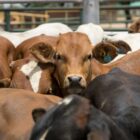Transforming the global food system is urgently required to nourish populations more effectively, conserve natural resources, promote animal welfare, and provide sustainable livelihoods to billions of farmers and food system workers.
In search of ever-higher yields, industrial food production has created ecological, social, and economic vulnerabilities by relying on genetically homogeneous crops, intensive animal confinement, corporate control of farms, and heavy use of synthetic chemicals.[1] This industrial production model has also generated inequitable distribution of wealth and power in the food system and rising disparities in access to healthy food.
Agroecology presents an alternative agricultural paradigm rooted in a systems-based understanding of ecological interactions in the farming landscape and the social context of farming. Agroecology seeks to transform agriculture by re-embedding broader ecological and societal wellbeing into food production and restoring control of food chains to local communities.
WHAT IS AGROECOLOGY?
Agroecology is a concept with a long and complex history. Today, the term simultaneously refers to a scientific discipline, a set of agricultural practices, and a social movement to restore ecological balance and economic justice to food systems.[2] The term originated in the 1930s among German agricultural scientists investigating the network of biological and ecological relationships underpinning farming. Environmental movements from the 1960s through the 1980s merged agroecological knowledge with critiques of urbanization, industrial farming, and natural resource depletion. A series of alternative agricultural practices[3] were defined with the potential to address systemic social and economic challenges in farming communities. These practices formed the basis for social-economic movements across Latin America in the 1990s.[4]
Agroecology is a systems-based approach to reforming current food systems that integrates the ecological, sociocultural, technological, economic, and political aspects of food production. Agroecology rejects the linear view of inputs and outputs dominant in conventional agriculture, acknowledging that agricultural production occurs in a complex social and ecological web.
Central to the strategies of agroecology is the understanding that an agricultural system should resemble the local ecosystem, with healthy nutrient cycles, complex structures, and optimal biological diversity.[5] To achieve this goal, agroecological practitioners promote crop diversification and oppose monocropping, chemical pesticide and fertilizer use, intensive animal farming, and extractive practices that hasten environmental degradation.
Integrating local and traditional knowledge with biological and agricultural sciences is an important component of agroecology. Unlike dominant industrial farming, agroecology does not separate issues like food security, biodiversity, human health, and economic stability from food production. The Food and Agriculture Organization of the United Nations (FAO) considers agroecology key to creating sustainable food systems and meeting the 2030 Agenda for Sustainable Development goals.
WHAT’S THE DIFFERENCE BETWEEN AGROECOLOGY AND SUSTAINABLE AGRICULTURE?
Agroecology shares many goals with the pursuit of sustainable agriculture while also engaging with cultural and political aspects of food production that heavily impact the resilience of food systems.[6] The Pesticide Action Network asserts that the principles of agroecology form the foundation for sustainable agriculture. At the same time, the Food and Agriculture Organization of the United Nations (FAO) views agroecology as an approach to sustainable agriculture that “simultaneously applies both ecological and social concepts.”
Sustainable agriculture covers a wide range of practices and strategies that also feature in agroecology, including crop diversity, crop rotation, and avoidance of antibiotics and synthetic agrichemicals. Agroecology may diverge from some forms of sustainable agriculture by incorporating a greater focus on traditional knowledge systems and smallholder producers.[7]
AGROECOLOGY IN RELATION TO PERMACULTURE
Permaculture, a portmanteau of “permanent agriculture,” is a movement founded in the 1970s with an ecological and social vision similar to agroecology. Permaculture focuses on agroforestry, perennial polycultures, production of food rather than commodity crops, and “harmonious integration” of land, people, and sustainable approaches to human energy and shelter needs.[8] Like agroecology, permaculture may refer to a worldview, a set of practices, or a design system.
While the agroecology movement is strongly connected to the wellbeing of Indigenous and smallholder farmers, critiques of the permaculture movement have highlighted unattributed similarities with Indigenous agricultural practices and questioned permaculture’s mostly white, high-income following and the high cost of popular certification programs.
AGROECOLOGY IN RELATION TO ORGANIC AGRICULTURE
Organic agriculture promotes ecological balance through the use of cover crops, crop rotation, and green and animal manures. Organic farmers avoid synthetic fertilizers, pesticides, hormones, and antibiotics. As such, organic farming aligns with many goals of agroecology related to the health of agroecosystems.
However, commercial organic farming works within rather than against the industrial agriculture system, falling short of the transformative and communal requirements of agroecology. Organic agriculture does not necessarily empower small landholders or strengthen local ecosystems, and large multinational companies still frequently control the profits of organic agriculture. While organic farms provide better care for the environment by eliminating toxic chemicals and synthetic inputs, the price premium of organic products may contribute to access disparities for low-income consumers.
WHAT ARE THE TEN ELEMENTS OF AGROECOLOGY?
The ten elements of agroecology were developed by the FAO as an analytical tool to assist policymakers, stakeholders, and communities in implementing agroecology principles. They are intended to be adapted to local social and ecological contexts under the guidance of rural and Indigenous producers.
DIVERSITY
Diversity is a key concept in agroecology that addresses the ecological, socioeconomic, and genetic heterogeneity of agricultural systems and supports the UN Sustainable Development goals. Vertical diversity is achieved when crops are intermingled with shrubs and trees to create different strata. Spatial diversity uses strategies like intercropping—whereby complementary species are grown together, and crop rotations over time achieve temporal diversity. Such crop diversity can improve soil health, water conservation, and pollinator health, while the reintroduction of traditional crops with higher nutrient values can improve health outcomes. Diversity also expands local markets and gives growers a wider range of income-generating opportunities.
CO-CREATION AND SHARING OF KNOWLEDGE
Agroecology depends on integrating traditional and Indigenous knowledge with scientific expertise to develop more resilient production systems. Co-creation and knowledge-sharing promote active participation among community members, whose knowledge of local agricultural ecology and management, markets, and sociocultural institutions is crucial to food system reform. Co-creation values both formal and informal education and recognizes that creating communities resistant to climate change and other challenges requires a wide, inclusive approach.
SYNERGIES
Achieving synergies is an agroecology design principle that provides multiple benefits to food production systems. Synergies are enhanced when crops, animals, and aquaculture are combined in mutually beneficial ways. Integrated systems—like rice cultivation in Asia that also supports aquaculture and tree growth—can provide ecologically sound solutions for soil erosion, pest control, and nutrient cycling.
EFFICIENCY
Agroecology improves efficiency by leveraging diversity and synergies to reduce dependence on external inputs. The principle of efficiency emphasizes the thoughtful and calculated use of natural resources in place of costly and environmentally unsustainable inputs typical of industrial food production.
RECYCLING
Natural ecosystems have effective closed-loop cycles for nutrient, biomass, and water recycling. Recycling in agroecology mimics ecological processes at both small and large scales to reduce waste, pollution, and nutrient loss. Forests of deep-rooted trees can utilize nutrients that go unused by annual crops, and organic materials can be recycled through composting. Closing nutrient and waste cycles increases farms’ resilience to climate change and market fluctuations.[9]
RESILIENCE
Resilience is a central aspect of agroecology and a guiding principle for food system reform. Production systems that are not dependent on single crops, export markets, and chemical inputs can better resist natural disasters, climate shocks, economic downturns, and pest and disease outbreaks. When producers are less vulnerable to external factors and are able to produce varied crops from diversified, ecologically appropriate landscapes, their local communities also benefit from greater food security and food sovereignty.[10]
HUMAN AND SOCIAL VALUES
Agroecology prioritizes farmer empowerment and dignity, equity, inclusion, and justice for both agricultural producers and food consumers. The human and social values articulated by agroecology support the autonomy, economic viability, and sustainability of farmers, recognize food as a fundamental human right, acknowledge environmental stewardship as necessary work on behalf of future generations, and confront inequalities such as gender disparities and unemployment.
CULTURE AND FOOD TRADITIONS
The element of culture and food traditions acknowledges that 800 million people experience chronic hunger, while simultaneously almost 2 billion people suffer from overweight and preventable diet-related illnesses in a global food system that has become drastically unbalanced. Modern eating habits have become disconnected from tradition, culture, and ecological harmony. Agroecology seeks to reintegrate traditional knowledge and cultural heritage into food systems.
RESPONSIBLE GOVERNANCE
Responsible governance calls for policies and laws to support agroecological transitions at multiple levels through increased transparency, inclusivity, and accountability. National and local policy can incentivize agroecological practices, while community-level programs can support farmer empowerment and knowledge sharing. Equitable governance of land and natural resources is necessary to ensure food access and stable farmer livelihoods.
CIRCULAR AND SOLIDARITY ECONOMIES
Circular and solidarity economies are modeled on closed-loop processes within natural ecosystems, prioritizing resource conservation, waste avoidance, sharing, reusing, refurbishing, and recycling. Compared to industrial agriculture, which separates consumers from producers through long supply chains, circular and solidarity economies restore connections between farmers and food users. Shortening supply chains and increasing opportunities for local markets can increase farmer income and contribute to healthier diets.
HOW DOES AGROECOLOGY WORK?
Because of the wide variation in global ecosystems, cultures, and environments, there is no one way to apply the concepts of agroecology. Instead, agroecology principles are meant to be customized to local realities and implemented by cooperative grassroots leadership.
EXAMPLES OF AGROECOLOGY
Successful implementation of agroecology by small farms in Malawi has improved nutrition for local communities facing food insecurity.[11] In South America, Indigenous knowledge has contributed significantly to agroecological approaches,[12] as in raised-bed cultivation systems that deliver crucial seasonal water management in Venezuela, Colombia, Ecuador, and Peru.[13] In the United States, community-supported agriculture movements have led to direct connections between farmers and consumers and a lower environmental impact than industrial farming.[14]
WHAT ARE THE BENEFITS OF AGROECOLOGY?
RESILIENCE AND SUSTAINABILITY
A growing body of scientific literature demonstrates that agroecological production systems recover better from climate shocks, are more pest-resistant, and generate lower greenhouse gas emissions than conventional agriculture. Case studies in Central America and Cuba have shown that agroecological farmers experienced significantly less damage than conventional, single-crop farmers when challenged by natural disasters.[15] Agroecology is associated with reduced land degradation, higher biodiversity, and greater resilience to climate change.[16]
AUTONOMOUS LIVELIHOODS
Agroecology emphasizes farmer autonomy, encouraging producers to replace agribusiness-controlled technologies and products with locally sourced, renewable inputs. By diversifying crops and creating systems that replicate the resource-conserving qualities of natural ecosystems, producers can avoid accruing farm debt and achieve greater financial stability.[17] In a 2017 study, crop yields increased by 61%, and profits increased by 66% on farms that adopted agroecological practices.[18]
FOOD JUSTICE AND SOVEREIGNTY
Recognizing that food is a human right, agroecology aims to reduce hunger and improve nutrition by restoring control of food chains to local producer communities. Increased reliance on non-mechanized labor reallocates money from fossil fuels and agribusiness corporations to farming communities, creating additional employment opportunities that bolster local economies.[19] The participatory processes fostered by agroecology can also strengthen rural community bonds through learning and collaboration, increasing community resilience.[20]
ANIMAL WELFARE
Animals raised for food in conventional agriculture suffer cruel confinement and exploitation in service of agribusiness profits. Agroecology rejects the extractive and exploitative industrial model of animal production. While some agroecological farming approaches include domesticated animals, agroecology is also well-suited to plant-based production that does not use animals. Where animals are included, synergies can benefit both animals and crops.
CONCLUSION
Agroecology presents a powerful challenge to industrial agriculture. Agroecological approaches recognize the need to radically transform the current global food system to benefit people, animals, and the environment, restoring ecological and economic wellbeing to food production.
Meeting the needs of the world population while safeguarding natural resources, improving animal welfare, and mitigating climate change will require food systems redesigned for intersectional benefit. Food production must be sustainable, compassionate, resilient, culturally and ecologically appropriate, and universally accessible. As a strategy for returning control of food chains to local populations, promoting food sovereignty, and strengthening local ecosystems, agroecology provides a robust framework for food system transformation in the US and worldwide.
[1] Stephen R. Gliessman, “Transforming Food and Agriculture Systems with Agroecology,” Agriculture and Human Values 37 (May 2020): 547–548, https://doi.org/10.1007/s10460-020-10058-0.
[2] Gliessman, “Transforming Food and Agriculture Systems,” https://doi.org/10.1007/s10460-020-10058-0.
[3] Rafter Sass Ferguson and Sarah Taylor Lovell, “Permaculture for Agroecology: Design, Movement, Practice, and Worldview. A Review,” Agronomy for Sustainable Development 34 (April 2014): 251–274, https://doi.org/10.1007/s13593-013-0181-6.
[4] A. Wezel et al., “Agroecology as a Science, a Movement and a Practice. A Review,” Agronomy for Sustainable Development 29, no. 4 (December 2009): 503–15, https://doi.org/10.1051/agro/2009004.
[5] Miguel A. Altieri et al., “Agroecology and the Design of Climate Change-Resilient Farming Systems,” Agronomy for Sustainable Development 35 (July 2015): 869–890, https://doi.org/10.1007/s13593-015-0285-2.
[6] Miguel A. Altieri et al., Agroecology: The Science of Sustainable Agriculture, 2nd ed. (Boca Raton, CRC Press, 2018), https://regabrasil.files.wordpress.com/2018/10/agroecology-the-science-of-sustainable-agriculture-altieri.pdf.
[7] Miguel A. Altieri and Clara I. Nicholls, Agroecology and the Search for a Truly Sustainable Agriculture (Mexico City, United Nations Environment Programme, 2005), http://www.agroeco.org/doc/agroecology-engl-PNUMA.pdf.
[8] See endnote 3.
[9] Miguel A. Altieri et al., “Agroecology and the Design of Climate Change-Resilient Farming Systems,” Agronomy for Sustainable Development 35, no. 3 (July 1, 2015): 869–90, https://doi.org/10.1007/s13593-015-0285-2.
[10] Eric Holt-Giménez and Miguel A. Altieri, “Agroecology, Food Sovereignty, and the New Green Revolution,” Agroecology and Sustainable Food Systems 37, no. 1 (2013): 90–102.
[11] Moses Mosonsieyiri Kansanga et al., “Agroecology and Household Production Diversity and Dietary Diversity: Evidence from a Five-Year Agroecological Intervention in Rural Malawi,” Social Science and Medicine 288 (November 2021), https://doi.org/10.1016/j.socscimed.2020.113550.
[12] José Suárez-Torres et al., “Agroecology and Health: Lessons from Indigenous Populations,” Current Environmental Health Reports 4, no. 2 (June 2017): 244–251, https://doi.org/10.1007/s40572-017-0146-z.
[13] Altieri et al., “Agroecology and the Design of Climate Change-Resilient Farming Systems,” https://doi.org/10.1007/s13593-015-0285-2.
[14] John Gowdy and Philippe Baveye, “An Evolutionary Perspective on Industrial and Sustainable Agriculture,” in Agroecosystem Diversity: Reconciling Contemporary Agriculture and Environmental Quality, eds. Gilles Lemaire et al. (Academic Press, London, 2019), 425–433, https://doi.org/10.1016/B978-0-12-811050-8.00027-3.
[15] Miguel A. Altieri et al., “Agroecology and the Design of Climate Change-Resilient Farming Systems,” Agronomy for Sustainable Development 35, no. 3 (July 1, 2015): 869–90, https://doi.org/10.1007/s13593-015-0285-2.
[16] Laura Silici, “Agroecology: What It Is and What It Has to Offer” (International Institute for Environment and Development, June 2014), https://www.aesanetwork.org/wp-content/uploads/2018/02/14629IIED-1.pdf.
[17] See endnote 16.
[18] Colin Ray Anderson et al., “Origins, Benefits, and the Political Basis of Agroecology”, in Agroecology Now! Transformations Towards More Just and Sustainable Food Systems,eds. Colin Ray Anderson et al. (Palgrave Macmillan, 2021), 11-18, https://link.springer.com/chapter/10.1007/978-3-030-61315-0_2.
[19] Olivier De Schutter, “Agroecology, a Tool for the Realization of the Right to Food,” in Agroecology and Strategies for Climate Change, ed. Eric Lichtfouse (Springer, Heidelberg, 2012), 1–16, https://link.springer.com/chapter/10.1007/978-94-007-1905-7_1.
[20] Nils McCune et al., “Peasant Balances and Agroecological Scaling in Puerto Rican Coffee Farming,” Agroecology and Sustainable Food Systems 43, no. 7–8 (2019), https://doi.org/10.1080/21683565.2019.1608348.




